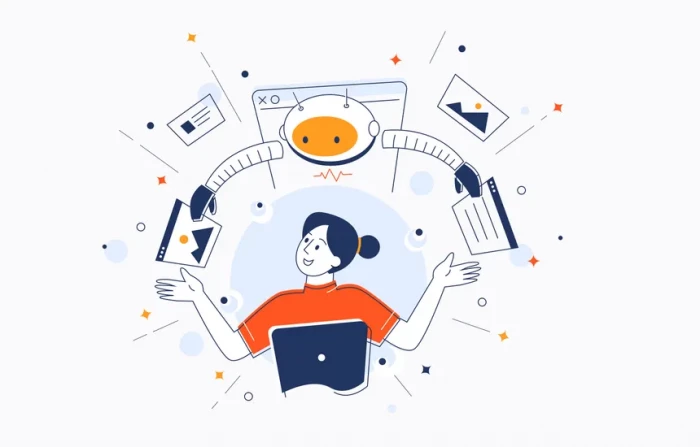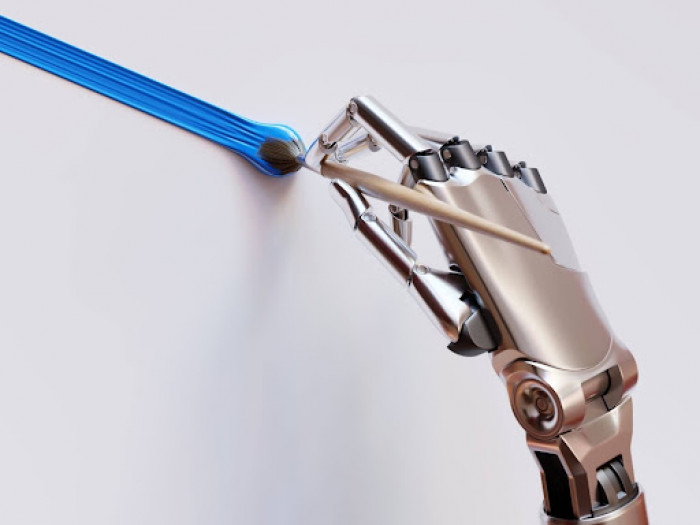Table of Content
We’ve wasted no time in finding new and unique ways to integrate AI technologies into a variety of industries – from facilitating automated workflows, to conducting diagnostics testing, boosting social media engagement, and even creative applications.
Graphic design is just one example of an industry where AI tools have made a tremendous impact – but it’s also one of the most interesting examples to observe, thanks in part to the great creative and efficiency potential AI has in this field in particular.
With the rise of AI, skilled graphic designers can now do their work at a fraction of the speed it used to take. AI has also made it possible for individuals without extensive graphic design experience to create basic image and video assets on their own.
Basic image and video generation aside, however, let's break down 5 of the other most compelling ways that AI is actively transforming the graphic design industry.
The Rise of 3D
Traditionally, most graphic designers have been trained to create 2D images. The status quo is quickly changing, however, thanks to the rise of virtual reality, interactive ads, and more complex game designs. To meet this challenge, designers are increasingly making use of AI tools for 3D asset generation.
If you’re looking to use AI for graphic design, dabbling with 3D asset generation could actually be one of the most challenging but rewarding places to start. With the right prompt engineering, graphic designers can use generative AI tools to not only produce 3D rendered images based on text prompts, but also potentially even animate these images by popping them into AI-powered animation software.
3D asset generation boasts immense personal and commercial value. For starters, we’re already seeing 3D avatars (like the Meta avatars, for instance) pop up all over socials. These new 3D avatars can also be turned into stickers, display photos, and even in-game avatars.
3D asset generation tools also allow designers to build 3D product models, create lifelike video game characters, and design ready-to-publish ads that users can zoom into and interact with in a variety of other ways.
Increased Efficiency
Perhaps the most significant way that AI has impacted the graphic design industry is that it's made it much easier to produce high-quality work in a fraction of the time that it used to take. More industry professionals are looking to use AI for graphic design
A quick Google search will reveal a plethora of AI-powered graphic design tools, each specialising in a slightly different function. If you're looking to automate large-scale design tasks, for example, Adobe Sensei is for you.
On the other hand, if you're a product designer looking to come up with realistic prototypes, tools like Uizard have all the functionalities you need. Even tools that have been staples among graphic designers for years, like Adobe Photoshop, have incorporated AI in order to improve user experience.
And of course, there are also tools like BioGPT, that makes it quicker and easier to generate snappy bios, captions, hashtags, and even post ideas for your social media. When it comes to boosting your efficiency as a digital creative, utilising both these graphic design tools as well as digital marketing and social media tools like BioGPT are naturally going to help you deliver more, higher value content across more campaigns.
Prompt Engineering as a New Skill

So what can graphic designers do with all this extra time provided to them by efficiency-boosting AI tools? Well, they can start honing even more digital skills and gain proficiency with even more graphic design tools! For instance, it’s becoming increasingly essential for graphic designers to master the art of prompting generative AI tools. And much like many other digital specialists, graphic designers can seriously elevate their CVs by adding ‘prompt engineering’ to their list of skills.
A good gen AI prompt contains several key elements. First, it's important to be concise while including all necessary details. Designers also need to get into the practice of using descriptive words like ‘hyper-realistic’, ‘magenta’ and ‘rectangular’.
Moreover, it's important to be familiar with the different art styles a particular generative AI tool can use in order to play to its strengths. When prompted effectively, AI software like Midjourney and Firefly can produce work that's almost indistinguishable from that of human beings.
Quicker Editing
AI is a powerful tool for building images and videos from scratch, but it can also be used to edit existing visuals. Software like AI Ease and Media.io can be used to identify and remove blemishes that might not be spotted by the naked eye at first glance.
Moreover, video editing has also become easier than ever. Thanks to tools like Adobe Premiere Pro and Final Cut Pro, it’s now possible to automate the process of adjusting elements such as color balance and lighting.
These tools can also enhance audio, create transitions and seamlessly overlay new speech over existing videos. With the power of AI, designers can now tailor existing still images and video footage to match their clients’ precise needs in a matter of minutes.
Using AI Responsibly in Design
That said, it’s important to go into the world of AI design with your eyes wide open. While these tools are powerful and can dramatically speed up the creative process, they’re not without their limitations.
One of the biggest concerns is originality. Since AI learns from existing data, there’s always a risk that what it creates isn’t entirely new — it might echo someone else’s work just a little too closely. Then there’s the issue of bias.
Because AI models are trained on huge data sets, they can inadvertently reflect biases present in that data, whether it's related to gender, race, or cultural assumptions. That’s why human oversight is still essential.
At the end of the day, AI is a tool, not a replacement for human creativity. The best outcomes happen when designers use AI to handle the time-consuming or technical aspects of the job, freeing themselves up to focus on the more strategic and creative elements. It’s still your vision, your taste, and your expertise that bring a project to life.
How AI Will Continue to Transform Graphic Design
AI has changed the world, and few industries have felt that shift as profoundly as graphic design. From speeding up workflows to unlocking creative possibilities that were once reserved for only the most skilled professionals, AI tools are redefining what’s possible.
No matter if you’re looking to generate hyper-realistic visuals, build immersive 3D experiences, or automate repetitive editing tasks – AI is streamlining all of this and more, giving designers more time and freedom to focus on what really matters: creativity, storytelling, and impact.
But AI isn’t just for seasoned professionals. It’s also empowering entrepreneurs, marketers, and small business owners to create polished, professional designs without years of training. With the right tools and a bit of curiosity, anyone can elevate their visual content and stand out in a crowded digital landscape.
Still, it’s important to remember that while AI can do a lot, it’s not a replacement for your unique perspective. The best results come from combining the speed and precision of AI with the creativity, taste, and intuition only a human can bring.
Whether you're a veteran designer exploring new ways to work or someone just starting to experiment with visuals, now is the time to embrace the future. AI is no longer the next big thing – it’s already here. So get to experimenting.


